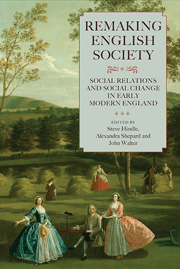Book contents
- Frontmatter
- Contents
- List of Illustrations, Figures, Maps and Tables
- Acknowledgements
- Notes on Contributors
- List of Abbreviations
- 1 The Making and Remaking of Early Modern English Social History
- 2 Brokering Fatherhood: Illegitimacy and Paternal Rights and Responsibilities in Early Modern England
- 3 Gender, Sexuality and the Consumption of Musical Culture in Eighteenth-Century London
- 4 Where was Mrs Turner? Governance and Gender in an Eighteenth-Century Village
- 5 Local Arithmetic: Information Cultures in Early Modern England
- 6 Intoxicants and the Early Modern City
- 7 Food, Drink and Social Distinction in Early Modern England
- 8 Written Obligations, Litigation and Neighbourliness, 1580–1680
- 9 Witchcraft and Neighbourliness in Early Modern England
- 10 Deference, Paternalism and Popular Memory in Early Modern England
- 11 Work, Reward and Labour Discipline in Late Seventeenth-Century England
- 12 Living in Poverty in Eighteenth-Century Terling
- 13 From Commonwealth to Public Opulence: The Redefinition of Wealth and Government in Early Modern Britain
- Appendix: Bibliography of the Published Writings of keith Wrightson from 1974 to 2011
- Index
- Tabula Gratulatoria
- STUDIES IN EARLY MODERN CULTURAL, POLITICAL AND SOCIAL HISTORY
8 - Written Obligations, Litigation and Neighbourliness, 1580–1680
Published online by Cambridge University Press: 05 May 2013
- Frontmatter
- Contents
- List of Illustrations, Figures, Maps and Tables
- Acknowledgements
- Notes on Contributors
- List of Abbreviations
- 1 The Making and Remaking of Early Modern English Social History
- 2 Brokering Fatherhood: Illegitimacy and Paternal Rights and Responsibilities in Early Modern England
- 3 Gender, Sexuality and the Consumption of Musical Culture in Eighteenth-Century London
- 4 Where was Mrs Turner? Governance and Gender in an Eighteenth-Century Village
- 5 Local Arithmetic: Information Cultures in Early Modern England
- 6 Intoxicants and the Early Modern City
- 7 Food, Drink and Social Distinction in Early Modern England
- 8 Written Obligations, Litigation and Neighbourliness, 1580–1680
- 9 Witchcraft and Neighbourliness in Early Modern England
- 10 Deference, Paternalism and Popular Memory in Early Modern England
- 11 Work, Reward and Labour Discipline in Late Seventeenth-Century England
- 12 Living in Poverty in Eighteenth-Century Terling
- 13 From Commonwealth to Public Opulence: The Redefinition of Wealth and Government in Early Modern Britain
- Appendix: Bibliography of the Published Writings of keith Wrightson from 1974 to 2011
- Index
- Tabula Gratulatoria
- STUDIES IN EARLY MODERN CULTURAL, POLITICAL AND SOCIAL HISTORY
Summary
Elizabethans and Jacobeans living through the most dramatic per capita increase in litigation levels in English history lamented the weakening of personal and community relations that growing litigiousness both produced and embodied. In 1576 a parliamentary bill complained of the ‘multitude of contentions which for lack of charity rise upon the smallest occasions between neighbours’, while in 1626 Walter Cary identified the ‘infinite number of suits’ at law as one of the three ills of the age that had grown dramatically over his lifetime. To those observers who regarded rising prices for foodstuffs and a growing tendency for creditors to charge interest on loans as expressions of greed, rather than as responses to economic change and rising demand, the expansion of litigation was simply a further manifestation of ‘the replacement of the values of the commonwealth with those of commodity and covetousness’. As Robert Burton reflected in The Anatomy of Melancholy (1621), ‘now for every toy and trifle they goe to law … ready to pull out one anothers throats, and for matters of commodity, to squise blood … out of their brothers heart’.
Neighbourly relations, it seems, were under attack from all sides. Torrents of insults flying back and forth in fields and on doorsteps produced an unprecedented surge of defamation suits in the church courts. In many regions criminal prosecutions were also rising, including those for the new statutory crimes of witchcraft and infanticide, and pamphlets publicised infamous murders and bemoaned growing social disobedience and religious dissension.
- Type
- Chapter
- Information
- Remaking English SocietySocial Relations and Social Change in Early Modern England, pp. 189 - 210Publisher: Boydell & BrewerPrint publication year: 2013



